Marcia Thornton Jones's Blog, page 25
November 28, 2023
You Don't Know What You've Got Til It's Gone...
by Charlotte Bennardo
 Photo by Nao Triponez: https://www.pexels.com/photo/black-st...
Photo by Nao Triponez: https://www.pexels.com/photo/black-st...
It seems good things never last; that perfect beverage, the perfect day, the perfect moment. So many things we wish could last forever, but alas, are too fleeting. Here are 5 things I wish could (and should) last longer:
 Photo by Perfecto Capucine: https://www.pexels.com/photo/black-am...
Photo by Perfecto Capucine: https://www.pexels.com/photo/black-am...1. Summer. It's way too short. I love living/writing/relaxing poolside, working in my garden, chilling on the seashore, hiking in the woods, cycling on new trails.
 Photo by Lina Kivaka: https://www.pexels.com/photo/woman-co...
Photo by Lina Kivaka: https://www.pexels.com/photo/woman-co...
 Photo by Snapwire: https://www.pexels.com/photo/orange-t...
Photo by Snapwire: https://www.pexels.com/photo/orange-t...3. Our pets' lives. They pass too soon from our lives and over the rainbow bridge.
 Photo by Diva Plavalaguna: https://www.pexels.com/photo/multirac...
Photo by Diva Plavalaguna: https://www.pexels.com/photo/multirac...4. Life. Most of us won't live to see 100, and even if we did, our failing bodies might make it unappealing. Wouldn't it be great to have health for at least 100 years? I could write sooo many more books, visit places, enjoy my kids and grandkids, and maybe even great grandkids.
 Photo by RDNE Stock project: https://www.pexels.com/photo/man-in-w...
Photo by RDNE Stock project: https://www.pexels.com/photo/man-in-w...5. Our favorite books. It seems even if they are a series, they're never long enough! We just want to stay in that world.
There are many more things, but those are high on my list. Until next time....
Charlotte writes MG, YA, NA, and adult novels in sci fi, fantasy, contemporary, and paranormal genres. She is the author of the award-winning middle grade Evolution Revolution trilogy, Simple Machines, Simple Plans, and Simple Lessons. She co-authored the YA novels Blonde OPS, Sirenz, and Sirenz Back in Fashion. She has two short stories in the Beware the Little White Rabbit (Alice through the Wormhole) and Scare Me to Sleep (Faces in the Wood) anthologies. Having finished her MFA, she's applying what she learned and is working on several children's and adult novels, along with some short stories. She lives in NJ with her family and her floofy cat. When they trimmed the backyard tree, the crazy squirrel couple had to move out.
November 25, 2023
What I Wish Could Last
 Those perfect moments that are gone before you can truly realize how perfect they are...
Those perfect moments that are gone before you can truly realize how perfect they are...Wishing you all the best of the rest of your Thanksgiving weekend...
~
Holly Schindler is an author of books for readers of all ages.
November 23, 2023
"Brainstorm:" Smack Dab in the Imagination by Dia Calhoun
Dear Gentle Reader,
On this Thanksgiving Day, I am very grateful (and surprised) that my poem for adults about imagination, "Brainstorm," was published in the excellent literary magazine, The Nashville Review. I hope it sends your own imagination into new places.
May your Thanksgiving Day be filled with whatever community you hold dear.
Singing praises,
Dia
November 14, 2023
The Breakout Outline with a Twist
Sooner or later, every writer needs to use an outline tohelp weave together various literary components. This is especially true ifthere is a large cast of characters or a multi-layered plotline. Agents oftenrequest outlines before seeing the full manuscript. Publishers will requirethem if an option novel is proposed. There is no magic number for how manypages an outline needs to be effective. As with everything else grounded in thecreative, it depends upon your purpose. Many long-winded outlines can be justas useless as those not long enough.
Remember, an outline is a blueprint that reflects thestructures that will bear the weight of the story dynamics. An effectiveoutline illustrates the causal chain – the spine of the story. It also reflectsboth the action (external) and the emotional (internal) plot movements.
I start by using this template by Donald Maass (The BreakoutNovel Workbook, 2004) because itsharpens the focus of the narrative. Also, it works very well during therevision process, when you outline your draft to help add texture.
What are the Key Action (External) Plot Fundamentals? (Write down thefollowing)
*Where is your novel set? Who is your main character, and what is hisprimary conflict or goal?
*What does your protagonist’s most want and why?
*What is your protagonist’s second plot layer? What is your protagonist’sthird plot layer?
*What is the first subplot? What is the second subplot?
*Who is the most important secondary (supporting) character, what is hisprimary conflict, and what does he most want?
*Who is the novel’s antagonist, what is his primary conflict or goal, and whatdoes he most want?
Avoid the Sagging Middle (Write down the following)
*What are the five biggest steps toward the solution of the centralconflict? In other words, what are the five turning points or events, includingthe story’s climax, that take place in the narrative?
*What are the five most important steps toward, or away from, what yourprotagonist most wants? These steps are consequences of choices that theprotagonist makes. This step helps identify the causal chain that creates theplot’s spine.
*What are the three most important steps (each) toward, or away from, theresolution of your first and second subplot?
*What are the three most important steps (each) toward, or away from, theresolution of the plot layers?
*What are the three most important steps toward, and away from, the resolutionof each main conflict facing your secondary characters and your antagonist?
What is the Key Emotional (Internal) Plot Fundamentals (Write down thefollowing)
*Two moments of strong inner conflict.
*Three larger-than-life actions.
*Two moments frozen in time. (For example, Juliet laments over Romeo, as Romeolistens below. Their first kiss erases all the wrongs of the past and ignoresall future conflicts. Another example: Eliot says good-bye to ET, and ETresponds with a gesture, saying: I’ll be right here.)
*Two measures of change.
How to Organize the Outline
You can adapt any narrative template to an outline. If youwere using the hero’s journey, for example, it would look something likethe outline below. The key to using the hero's journey is understanding what the plot points(outlined above) represent and how they relate to the broader movements. However, if you want something easier, try using the three-act narrativestructure. I’ve inserted the three-act structure in the outline below tocorrespond to these movements so you can see how it compares.
By the way, the outline is not carved in stone. As youorganize the information, you may discover a break in the causal chain that needsattention, or the emotional plot needs more cues. Easy peasy just adapt the outline! That just meansthe outline is working!
(Act One) Departure
(Set-up) The Ordinary World (The Inciting Incident) The Call to Adventure (Second Thoughts) Refusing the Call to Adventure Meeting the Mentor(Climax to Act One) Crossing the Threshold (Act Two) Initiation(Obstacles) Test, Allies, and Enemies(Crisis) Approach to the Inmost Cave(Big Twist) The Ordeal(Climax of Act Two) The Reward (Act Three) Return
(Descending Action) The Road Back(Climax of Act Three) Resurrection(Wrap-up) Return with the Elixir
Next, just fill in each point by depicting that specificpivotal moment (noted above). Don’t summarize everything: just highlight that pivotal momentwhen something changes, either in the character or in the plot.
 Syd Field (Screenplay: The Foundations of Screenwriting, 2005) created the three-act narrative structure for screenwriters. However, it can be easily adapted to narrative structure.
Syd Field (Screenplay: The Foundations of Screenwriting, 2005) created the three-act narrative structure for screenwriters. However, it can be easily adapted to narrative structure. Now get writing!
--Bobbi Miller
Connections - Guest Post by Laura Segal Stegman, Author of Summer of L.U.C.K. and Ready or Not
If I had to come up with a word – other thanperseverance – to describe the most important tool in my middle grade writer’skit, it’s “connections.” Not someone who “only got the job because ofconnections…” I mean "connections" defined as building relationshipswith other writers in my genre. Those connections have been essential during myjourney as a traditionally published middle grade author with ananything-but-traditional path to publication.
First of all, it took almost twenty years from when Ibegan to write Summer of L.U.C.K., my debut middle grade novel, to whenit was first published in 2020. Although I'd already developed excellentbusiness writing skills in my profession as a public relations consultant, myfiction writing abilities were nonexistent. After working with an amazingdevelopment editor, my abilities took a giant leap when I learned to makeconnections in the middle grade writing community, mostly through social media.These included other writers in my genre with whom I engaged and got to know ascritique partners, Beta readers, fellow query-ers, fellow cheerleaders, andsimply listening ears and reading eyes.
Despite the decades it took to make Summer ofL.U.C.K. good enough to attract a publisher, its sequel, Ready or Not,took less than sixteen months to write. The Chambered Nautilus, thethird and final in the L.U.C.K. trilogy, took only twelve. The progress I’vemade is due in large part to everything I learned (and am still learning) aboutwriting and publishing middle grade kidlit from my connections.
When I secured a three-book publishing contract, beginningwith Summer of L.U.C.K., the connections I made by joining a 2020 MiddleGrade/YA Debuts Facebook group opened doors in ways I never expected, fromadvice about dealing with agents and editors to news of promotionalopportunities, such as interviews and other publicity, including the chance tobe featured in a TikTok/BookTokinfluencer’s video. No, I didn’t become an internet sensation, but it wasfun anyway.
 All the books in Laura's co-marketing group.
All the books in Laura's co-marketing group.
Like so many of us, my post-debut publication roadwasn’t smooth. Less than a year after Summer of L.U.C.K. was publishedand several months before Ready or Not was set to follow, my publisherclosed its doors, leaving L.U.C.K. and the two sequels out in the cold.At that low point, my connections provided moral support. It's amazing how muchit helps when you hear, "That [or something like it] happened to me too,”especially from more than one person.
With a lot of luck, I was signed by a new publisher,which reissued L.U.C.K. lastyear, published Readyor Not in August of this year, and will issue TheChambered Nautlius next year. That’s the good news. The not-as-good news isthat I knew much of the marketing and promotion would fall on my shoulders. ButI turned that lemon into lemonade by reaching out to my connections andstarting the MightyMiddle Grade Authors, a co-marketing group of middle grade writers, whichhas opened more doors than I ever could have imagined.
I'm no social media expert, but if you’re wondering howI found middle grade writers and published authors with whom to follow andengage, I used hashtags like #MiddleGrade, #Kidlit, and #MGLit as a jumping offpoint on Twitter and Instagram. #WritingCommunity, #BookTwitter,#AuthorsCommunity, and #WritersCommunity are others, although they’re verygeneral. On Facebook, I searched Groups for “middlegrade” or “middle grade” or“kidlit.” I also started following authors of middle grade books that I liked,and checked who they followed.
Once I began making connections through social media,it was easier to make more. And while social media has changed dramaticallyover the last few years, there remains a strong writers community on everysocial platform, be it X/Twitter, Facebook, Instagram, TikTok, Slack, Discord,BlueSky, or Threads. I found the platforms and the hashtags that worked for meto establish my connections. So can you.
A final note… It goes without saying (but I’ll say itanyway) that you’ll need to tread carefully and learn all you can about peoplebefore establishing connections, ESPECIALLY agreeing to in-person meetups.Avoid anyone who wants you to pay for reviews, interviews, basic writinginformation, or the information you can find with a Google search. The internetis filled with free resources. Keep your eye on sites like Writer Beware and top-quality publishing sites likeJane Friedman's andJaniceHardy's.
Connection-making takes a lot of time but consider itan investment in yourself. It's been worth it for me, and I hope my experiencehelps others.
~
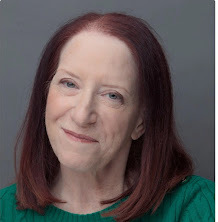 Daniel Reichert Photography
Daniel Reichert Photography
LauraSegal Stegmanis a Los Angeles-based publicity consultant and author whose middle grade debutnovel, Summer of L.U.C.K., and its sequel, Ready or Not (both Five-Star Readers'Favorite Award winners), are available wherever books are sold. The ChamberedNautilus, third in Young Dragons Press’ L.U.C.K. trilogy, follows in2024. L.A. Parent Magazine lauded Summer of L.U.C.K. as a "good read," and middlegrade/young adult author Frank Morelli praised Ready or Not as “filledwith magic, time travel, and a healthy dose of courage from its deeply authenticcast of characters.” Laura’s PR Tips for Authors workshop, a step-by-step guideto building a digital author media kit, has been presented by SCBWI, TheWriting Barn, and elsewhere. Non-fiction writing credits include collaborationon the travel book Only in New York.Her feature stories and guest posts have appeared in the Los Angeles Times, Los Angeles Magazine, and School Library Journal’s Teen Librarian Toolbox, among others. A Phi Beta Kappa graduateof UC Irvine with a B.A. in Drama, Laura serves as a judge for kidlit writercompetitions and shares her author journey in visits to schools and libraries. www.LauraStegman.com
Twitter: @LauraStegman
Instagram: @laura_stegman
Facebook: LauraSegalStegmanAuthor
November 12, 2023
9 Things I Wish Would Last by Darlene Beck Jacobson
1. The feeling I get from reading a great book
2. PEACE
3. Rainbows
4. Acts of Kindness
5. The feel of warm sun when I am cold and a gentle rain when I am parched
6. The satisfaction I feel after completing a new manuscript
7. The sound of children laughing
8. The taste of ice cream on a hot day
9. PEACE...AGAIN... because it never lasts long enough

Darlene Beck Jacobson can think of more than 9 things she wishes would last and tries to be present to enjoy each special moment as it happens.
She blogs at: http://www.darlenebeckjacobson.wordpr...
November 11, 2023
The End of the Line
 There comes a point in most every author visit—school, festival, bookstore—when readers line up to have their books signed. I love this part so much.
There comes a point in most every author visit—school, festival, bookstore—when readers line up to have their books signed. I love this part so much. Certainly, it's a happy day whenever anyone buys a book but, right then, my joy comes from those brief moments I get to spend with each of these readers.
The one-on-ones start with a little eye contact. I look at them; they look back at me. Well, most of the time. Some, in their shyness, are more comfortable casting their gaze at their book on the table. No matter what their personality, I try to connect on some level to make each one feel noticed.
Invariably, there are those who smash ahead to be first in line, beating out others who rushed nearly as fast. I usually joke about that: their eagerness their speed, their feeling of achievement at getting there so quickly.
While I’d love to have more than the minute it takes to sign and ask a question, there’s that line behind them.
In trying to be fair to all the kiddos who are waiting their turn, I cannot spend substantially more time with any one reader in particular, until...
 © https://www.123rf.com/profile_inspire... I reach the one at the end of the line. The very last. The one who’s had to wait the longest. It’s then that I thank this person for their patience. It’s then that I hold a mini-conversation. It’s then that I will extra-personalize their book based on something they've said. And if I’ve brought a giveaway with me that day, I always save one for the person at the end of the line. The last. But definitely not the least.
© https://www.123rf.com/profile_inspire... I reach the one at the end of the line. The very last. The one who’s had to wait the longest. It’s then that I thank this person for their patience. It’s then that I hold a mini-conversation. It’s then that I will extra-personalize their book based on something they've said. And if I’ve brought a giveaway with me that day, I always save one for the person at the end of the line. The last. But definitely not the least. P.S. Shhh! Don’t tell, or everyone will rush to be last.
Jody Feldman, author of The Gollywhopper Games and more, was a shy one who often found herself toward the end of some lines. While she’s mostly overcome her shyness, she still finds benefits in waiting in such circumstances. Well, most of the time.
November 9, 2023
Interview with K.H. Saxton, Author of The Fairfleet Affair
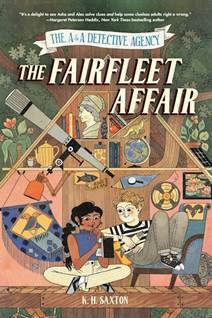
Thanks for joining us at Smack Dab! Give us a quick idea of what TheFairfleet Affair is about:
Thank you for having me! The A&A Detective Agency: The FairfleetAffair is about twelve-year-old detectives Alex Foster and Asha Singh, whohave their own established agency but no worthy cases… yet. Their primarybenefactor is the eccentric millionaire Dr. Alistair Fairfleet, chairman of theFairfleet Institute and its world-famous museums. When Dr. Fairfleet disappearsunder mysterious circumstances, he leaves behind a complicated trail of cluesand puzzles for Asha and Alex to follow. But The Fairfleet Affair ismore than a missing person case; as the detectives crack codes and make theirway through the different museums, they uncover art clues, archaeologicalmysteries, and Fairfleet family skeletons—secrets from the past that test theirpartnership and force them to confront the complicated legacies of the peopleand places they admire most.
I love a good mystery. This one’s so complex, with so many twists andturns–you’ve got to be a lifelong mystery lover yourself. Did you just gobbleup mysteries as a young reader? Or come to them later on in life?
I have a working theory that all narratives are mysteries at their core.No matter the genre, something has to hook us at the start of a story, and weare driven to keep reading as the author feeds us hints and new information toanswer our questions and help us to form a full picture of the characters andtheir conflicts. That said, I’ve always had a soft spot for classic detectivestories and cozy mysteries! I remember checking out every Nancy Drew book at mylocal library when I was in elementary school, and I moved on to prolificauthors like Agatha Christie not long after. I also took a fantastic detectivefiction course in college. Writing in this genre certainly feels familiar,satisfying, and nostalgic for me.
I love the fact that this starts off with a solar eclipse. Why did youchoose that event to kick the novel into gear?
As I’ve mentioned, there are many different kinds of mysteries at play inthis book. Some mysteries are solved by detectives, others are explored in artor curated in museums. It felt appropriate to start the story with a solareclipse to set the right sort of enigmatic tone and, at the same time, toinvite readers to think about some scientific, astronomical mysteries and thewonders of our natural world.
Mystery readers (and writers!) are all puzzle enthusiasts, I think. Thisone really has that puzzle feel, with so many moving pieces. Can you tell us abit about the drafting process? How did it all come together? I generally thinkyou have to know everything you can about a crime before writing how it getssolved. How did you approach a mystery?
I am a huge fan of puzzles—everything from crosswords to jigsaws—and Ican attest that creating codes and riddles is just as much of a puzzlingchallenge as solving them! I generally need to have the solution to a puzzlefirst, and I can build backward from there. Similarly, when crafting a mystery,I always know the answers to the most important questions (who are theculprits? what are their motives?) from the start so that I can placeappropriate clues and red herrings. I’ve heard of mystery writers who use thewriting process to figure out “whodunit” alongside their detectives, but Iwould worry about writing myself into a corner. Through writing and revising,however, I often discover unexpected moments or scenes, and I learn a lot aboutmy characters and their relationships that I didn’t know when starting out.
There’s a diverse cast here, which addresses some issues of historykeeping and culture. Can you speak to that a bit?
I believe that literature for young people should reflect the diversityof our world. Writing characters with backgrounds and experiences that differfrom our own, however, always carries with it the serious responsibility toresearch thoroughly, listen with humility, and proceed with care and respect. Ifelt this duty to my characters and their perspectives quite keenly in thesections of The Fairfleet Affair that focus on museum artifacts. Thebook asks readers to consider questions about museum curation: Whose culturalheritage is represented by the artwork and artifacts in museums? How do museumsacquire these objects? Where do we draw the line between appreciatinghumanity’s rich history and appropriation or outright theft? The characters in TheFairfleet Affair all approach these questions differently because of theirunique identities. Asha and Alex do not share exactly the same viewpoint;neither do their adult mentors. I hope that readers will bring their owncultures, family histories, and life experiences to the table when they read ortalk about the book.
I love the fact that the detective agency is Fairfleet’s own pet project.It gives credence to the agency, but it also immediately makes the reader thinkthat Fairfleet is imparting a message on the young detectives, as soon as thatletter arrives. Immediately, the puzzle solving begins! I always feel likemystery reading is such good training for life–life problems are puzzles,really. Do you often feel like you’re training young readers to be life problemsolvers?
Children are naturally adept at problem solving; it’s how we humanslearn, develop, and move through the world. As we grow older, the incentivestructures that we encounter—in school or in the workplace, for instance—cansometimes discourage risk-taking and creative thinking. Alex and Asha craveindependence; they want to be taken seriously. Dr. Fairfleet’s letter invitesthem to exercise their problem-solving skills, and his disappearance removestheir detective training wheels. They have to take risks and think creativelybecause no one else is going to solve the case for them. Reading a mystery inyour favorite book nook might not have the same high stakes as solving one inreal life, but I think a good mystery novel can present young readers withsimilar opportunities to test out theories, embrace difficulty, and ponder bigquestions on their own terms. And, of course, nothing builds confidence quitelike figuring out a piece of the puzzle before the big denouement!
I love a good detective book–I have fond Nancy Drew /Encyclopedia Brown memories (though that dates me). How does the FairfleetAgency fit in with the history of young detectives? How is it similar ordifferent?
It’s safe to say that The Fairfleet Affair would not exist withoutclassic middle-grade mysteries like The Westing Game by Ellen Raskin andFrom the Mixed-Up Files of Mrs. Basil E. Frankweiler by E.L. Konigsburg.I drew inspiration from these personal favorites throughout my writing process.Of course, the genre is alive and thriving today, and readers hoping to gettheir fill of puzzles and cryptic clues have so many great authors to choose from:Margaret Peterson Haddix, Varian Johnson, Jennifer Chambliss Bertman, and KateMilford, to name just a few. I like to think that The Fairfleet Affair benefitsfrom the nostalgia of a beloved tradition while still feeling up-to-date andaccessible for young readers. Asha and Alex want to be great detectives likethe characters they read about; they also grapple with some complex currentissues and work to build an equal friendship and partnership in a contemporarycontext.
You tackle some Shakespeare, etc., which helps introduce readers to somehistorical and cultural tidbits. Did you also want to light a fire in them,regarding history or research? (Research can be exciting, not dusty.)
Research can be exciting even when it is a bit dusty! But it isdefinitely the case that readers today have lightning-fast and dust-freeresearch tools at their disposal. When I was young, I learned so much abouthistory, literature, and art from allusions in the books that I loved; italways felt like the best kind of challenge to encounter unknown,intellectually invigorating details. If this book inspires some readers toGoogle the Nabataeans or watch scenes from King Lear online, I’d feelboth delighted and accomplished as an author!
What’s next for the detective agency?
In the second book of the series, the A&A Detective Agencyinvestigates a historical mystery related to the Northbrook witch trials alongwith a series of present-day break-ins at the local cemetery. The story is setin October, so the atmosphere is all about autumn and Halloween—one of myfavorite times of the year! Alex and Asha are also back in school; theirfriendship and the agency itself will experience some growing pains with theintroduction of a new cast of supporting characters. I can’t wait to share thisnext book with readers!
Where can we find you?
You can follow me on Instagram at khsaxton, and look for The A&A Detective Agency:The Fairfleet Affair at your favorite bookstore or onlinevendor!
November 8, 2023
LAST -- by Jane Kelley
November's blog topic is supposed to be "last." As I pondered the word, I wondered which of its meanings I should write about. The last? At last?
What about this kind of a last?
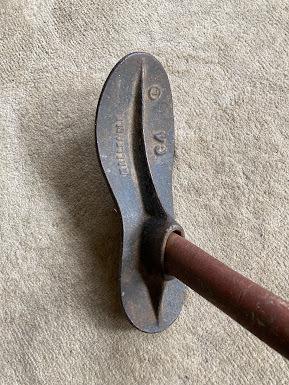
This thing has lasted through many phases. It was once a useful tool for repairing shoes. Then it became junk in my dad's basement. Now it's kitschy decor.
The object is the same. But when its story changed, it did too.
This is also true of our lives. We can't change events, but we can try to cope with unpleasant ones by reframing the narrative. A recent episode of Hidden Brain was about Changing Your Story to change your life. One of the techniques mentioned was to shift the end of the narrative.
In other words -- if bad things have happened and you're in a pile of junk in a basement -- that doesn't have to be the end of your story. There is more to come. And you, dear reader and writer, can do something that inanimate object can't. You can take action and be the hero of that story.
Oh -- one more thought. If you look closely, you can read the word MALLEABLE on the foot.
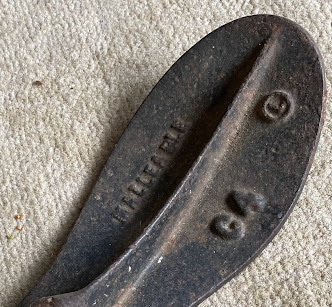
This thing is made of cast iron! "Malleable" is the last adjective I'd use to describe it. But hey -- someone sure reframed the narrative.
Jane Kelley is the owner of this last and the author of many middle-grade novels.
@font-face {font-family:"Cambria Math"; panose-1:2 4 5 3 5 4 6 3 2 4; mso-font-charset:0; mso-generic-font-family:roman; mso-font-pitch:variable; mso-font-signature:3 0 0 0 1 0;}@font-face {font-family:Calibri; panose-1:2 15 5 2 2 2 4 3 2 4; mso-font-charset:0; mso-generic-font-family:swiss; mso-font-pitch:variable; mso-font-signature:-520082689 -1073697537 9 0 511 0;}p.MsoNormal, li.MsoNormal, div.MsoNormal {mso-style-unhide:no; mso-style-qformat:yes; mso-style-parent:""; margin:0cm; mso-pagination:widow-orphan; font-size:12.0pt; font-family:"Calibri",sans-serif; mso-ascii-font-family:Calibri; mso-ascii-theme-font:minor-latin; mso-fareast-font-family:Calibri; mso-fareast-theme-font:minor-latin; mso-hansi-font-family:Calibri; mso-hansi-theme-font:minor-latin; mso-bidi-font-family:"Times New Roman"; mso-bidi-theme-font:minor-bidi;}p.Prose, li.Prose, div.Prose {mso-style-name:Prose; mso-style-unhide:no; margin:0cm; text-indent:36.0pt; line-height:200%; mso-pagination:widow-orphan; font-size:12.0pt; font-family:"Times New Roman",serif; mso-fareast-font-family:Calibri; mso-fareast-theme-font:minor-latin; mso-bidi-font-family:"Times New Roman"; mso-bidi-theme-font:minor-bidi; mso-ansi-language:EN-US;}.MsoChpDefault {mso-style-type:export-only; mso-default-props:yes; font-family:"Calibri",sans-serif; mso-ascii-font-family:Calibri; mso-ascii-theme-font:minor-latin; mso-fareast-font-family:Calibri; mso-fareast-theme-font:minor-latin; mso-hansi-font-family:Calibri; mso-hansi-theme-font:minor-latin; mso-bidi-font-family:"Times New Roman"; mso-bidi-theme-font:minor-bidi;}div.WordSection1 {page:WordSection1;}
November 3, 2023
9 Ways of Looking at Revision
Hello and Happy November! This month we're celebrating the number 9. And since I've just been in the throes of a big revision, I offer you this poem: "Nine Ways of Looking at Revision."
If you, too, are facing revision, I wish you safe passage!
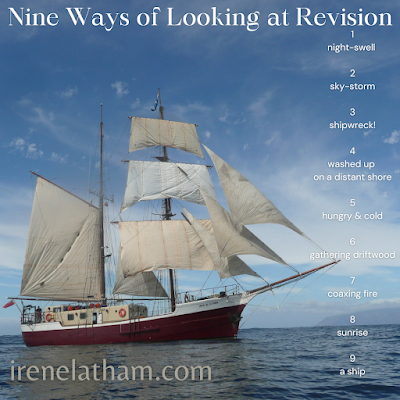
Nine Ways of Looking at Revision
1
night-swell
2
sky-storm
3
shipwreck!
4
washed up
on a distant shore
5
hungry & cold
6
gathering driftwood
7
coaxing fire
8
sunrise
9
a ship
- Irene Latham
Read hundreds more (free) poems at irenelatham.com!



